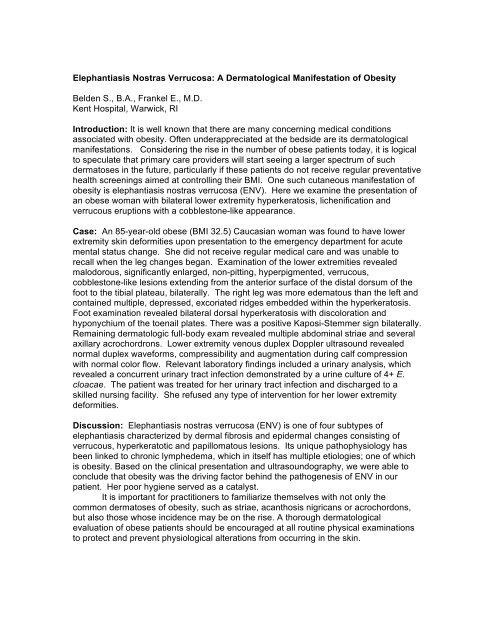Acute Flaccid Paralysis Accompanying West Nile Meningitis Ahmed ...
Acute Flaccid Paralysis Accompanying West Nile Meningitis Ahmed ...
Acute Flaccid Paralysis Accompanying West Nile Meningitis Ahmed ...
You also want an ePaper? Increase the reach of your titles
YUMPU automatically turns print PDFs into web optimized ePapers that Google loves.
Elephantiasis Nostras Verrucosa: A Dermatological Manifestation of Obesity<br />
Belden S., B.A., Frankel E., M.D.<br />
Kent Hospital, Warwick, RI<br />
Introduction: It is well known that there are many concerning medical conditions<br />
associated with obesity. Often underappreciated at the bedside are its dermatological<br />
manifestations. Considering the rise in the number of obese patients today, it is logical<br />
to speculate that primary care providers will start seeing a larger spectrum of such<br />
dermatoses in the future, particularly if these patients do not receive regular preventative<br />
health screenings aimed at controlling their BMI. One such cutaneous manifestation of<br />
obesity is elephantiasis nostras verrucosa (ENV). Here we examine the presentation of<br />
an obese woman with bilateral lower extremity hyperkeratosis, lichenification and<br />
verrucous eruptions with a cobblestone-like appearance.<br />
Case: An 85-year-old obese (BMI 32.5) Caucasian woman was found to have lower<br />
extremity skin deformities upon presentation to the emergency department for acute<br />
mental status change. She did not receive regular medical care and was unable to<br />
recall when the leg changes began. Examination of the lower extremities revealed<br />
malodorous, significantly enlarged, non-pitting, hyperpigmented, verrucous,<br />
cobblestone-like lesions extending from the anterior surface of the distal dorsum of the<br />
foot to the tibial plateau, bilaterally. The right leg was more edematous than the left and<br />
contained multiple, depressed, excoriated ridges embedded within the hyperkeratosis.<br />
Foot examination revealed bilateral dorsal hyperkeratosis with discoloration and<br />
hyponychium of the toenail plates. There was a positive Kaposi-Stemmer sign bilaterally.<br />
Remaining dermatologic full-body exam revealed multiple abdominal striae and several<br />
axillary acrochordrons. Lower extremity venous duplex Doppler ultrasound revealed<br />
normal duplex waveforms, compressibility and augmentation during calf compression<br />
with normal color flow. Relevant laboratory findings included a urinary analysis, which<br />
revealed a concurrent urinary tract infection demonstrated by a urine culture of 4+ E.<br />
cloacae. The patient was treated for her urinary tract infection and discharged to a<br />
skilled nursing facility. She refused any type of intervention for her lower extremity<br />
deformities.<br />
Discussion: Elephantiasis nostras verrucosa (ENV) is one of four subtypes of<br />
elephantiasis characterized by dermal fibrosis and epidermal changes consisting of<br />
verrucous, hyperkeratotic and papillomatous lesions. Its unique pathophysiology has<br />
been linked to chronic lymphedema, which in itself has multiple etiologies; one of which<br />
is obesity. Based on the clinical presentation and ultrasoundography, we were able to<br />
conclude that obesity was the driving factor behind the pathogenesis of ENV in our<br />
patient. Her poor hygiene served as a catalyst.<br />
It is important for practitioners to familiarize themselves with not only the<br />
common dermatoses of obesity, such as striae, acanthosis nigricans or acrochordons,<br />
but also those whose incidence may be on the rise. A thorough dermatological<br />
evaluation of obese patients should be encouraged at all routine physical examinations<br />
to protect and prevent physiological alterations from occurring in the skin.

















